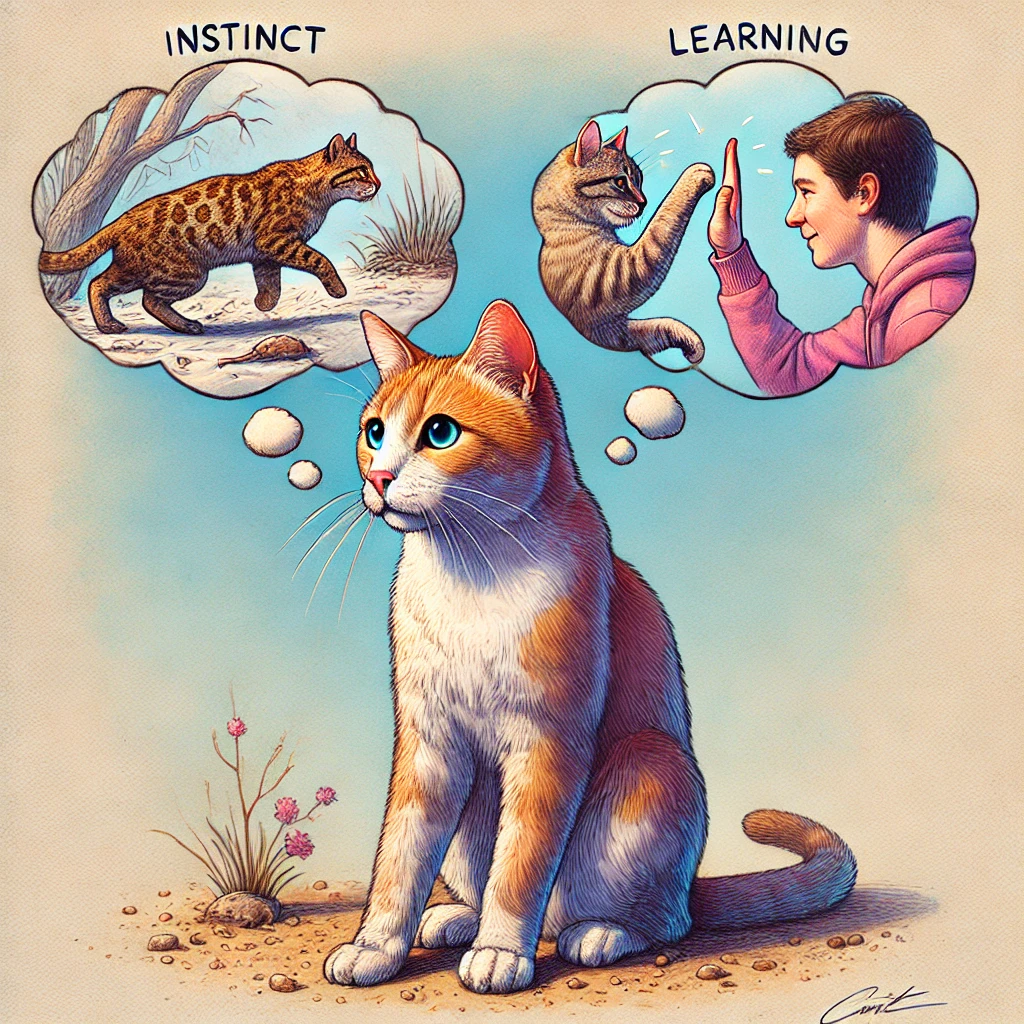Discover the difference between cat instincts vs learned behaviors to foster better communication and understanding with your feline friend.
Introduction
Cats are complex creatures with behaviors shaped by both instincts and learning. Understanding the balance between instinctual actions and those acquired through experience is crucial for addressing your cat’s needs effectively. In this article, we’ll explore common instinctual behaviors like hunting and scratching, how cats develop learned behaviors, the impact of genetics and upbringing, and provide tips for modifying unwanted actions. By decoding cat instincts vs learned behaviors, you can strengthen your bond with your feline companion.
Cat Instincts: Innate Behaviors in Cats
Instincts are innate behaviors that cats are born with, essential for their survival and well-being. Recognizing these instincts helps you provide appropriate outlets for your cat’s natural tendencies.
Hunting Instinct
The Predator Within
Cats are natural hunters, and this instinct drives them to stalk, pounce, and chase moving objects. Even well-fed domestic cats exhibit hunting behaviors because it’s hardwired into their DNA.
Play as Hunting Practice
Engaging in play that mimics hunting satisfies this instinct. Toys like feather wands and laser pointers stimulate their predatory drive. Learn more about feline play behavior.
Scratching Behavior
Marking Territory
Scratching sharpens claws, stretches muscles, and marks territory through scent glands in their paws. It’s an essential cat instinct that communicates with other animals.
Providing Scratching Posts
Offering suitable scratching surfaces prevents damage to furniture and allows cats to express this natural behavior. See our guide on choosing a scratching post.
Climbing and Perching
Seeking High Ground
Cats instinctively seek elevated areas to survey their environment, providing safety and a vantage point for hunting.
Creating Vertical Spaces
Cat trees and shelves satisfy this need for climbing and perching, reducing anxiety and promoting exercise.
Grooming Habits
Self-Care Routine
Grooming is an instinctual behavior for cleanliness and temperature regulation. It also serves as a way to relieve stress.
Social Grooming
Cats may groom each other or their owners as a sign of bonding and affection.
Learned Behaviors in Cats
Learned behaviors are acquired through interactions with the environment and experiences. These behaviors can be shaped and modified over time.
Environmental Influence
Adaptation to Surroundings
Cats learn from their environment, adapting behaviors based on what they find rewarding or discouraging.
Observation and Mimicry
Kittens often learn by observing their mother and littermates, adopting behaviors that they see.
Human Interaction
Positive Reinforcement
Cats may repeat behaviors that result in positive outcomes, like attention or treats. For example, they may learn to meow to get fed. Read about positive reinforcement techniques.
Negative Experiences
Negative interactions can lead to fear or aggression. A cat that is mishandled may become wary of human contact.
Habituation and Conditioning
Responding to Cues
Cats can learn to respond to specific cues or commands, such as coming when called or sitting on command.
Association of Events
They may associate certain sounds or routines with outcomes, like the sound of a can opener signaling mealtime.
The Impact of Genetics and Upbringing
Genetics and early life experiences play a significant role in shaping a cat’s behavior.
Breed Tendencies
Genetic Predispositions
Certain breeds have characteristic behaviors. For example, Siamese cats are known for being vocal, while Bengals are energetic and playful.
Selecting a Breed
Understanding breed traits can help you choose a cat that fits your lifestyle and expectations.
Early Socialization
Critical Development Period
The first few weeks of a kitten’s life are crucial for social development. Exposure to various stimuli helps them become well-adjusted adults. Learn about kitten socialization.
Handling and Human Contact
Kittens handled gently by humans are more likely to be friendly and comfortable around people.
Tips for Modifying Unwanted Behaviors
Addressing undesirable behaviors requires patience and consistency. Here are strategies to help modify your cat’s actions.
Positive Reinforcement
Reward Desired Behaviors
Offer treats, praise, or affection when your cat exhibits appropriate behavior. This encourages them to repeat it.
Redirecting Behaviors
Provide Alternatives
If your cat scratches furniture, provide a scratching post and encourage its use with catnip or toys.
Consistent Responses
Avoid Mixed Signals
Ensure all family members respond to behaviors in the same way to prevent confusion.
Environmental Enrichment
Stimulate Their Senses
Provide toys, puzzles, and interactive play to keep your cat mentally and physically engaged. Explore environmental enrichment ideas.
Professional Assistance
Consult a Veterinarian or Behaviorist
If unwanted behaviors persist, seek advice from professionals who can assess underlying issues.
Conclusion
Understanding the origins of your cat’s behaviors—whether instinctual or learned—empowers you to address their needs effectively. By recognizing the balance between cat instincts vs learned behaviors, you can foster better communication and a stronger bond with your feline companion.






